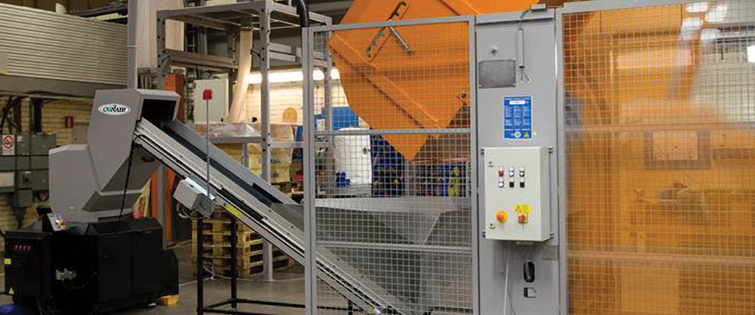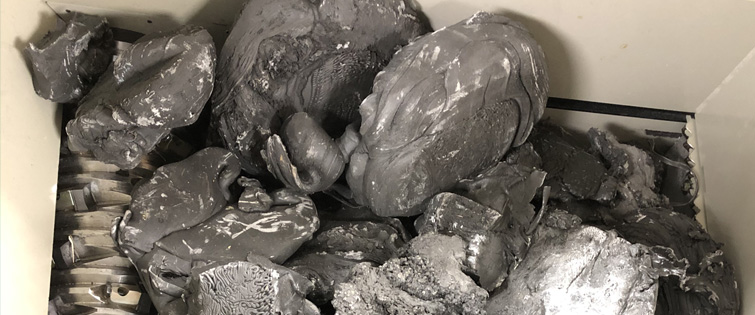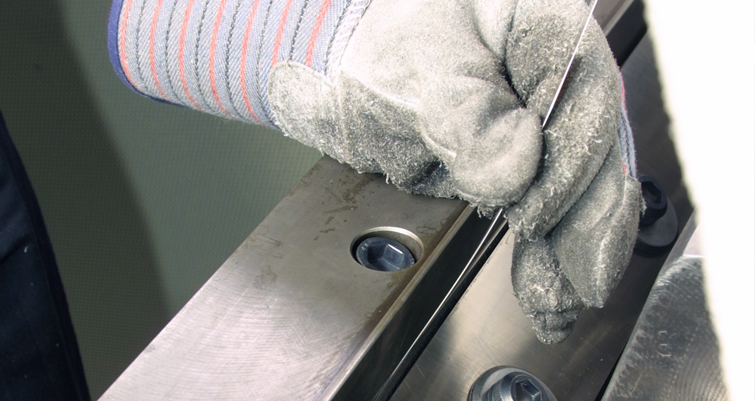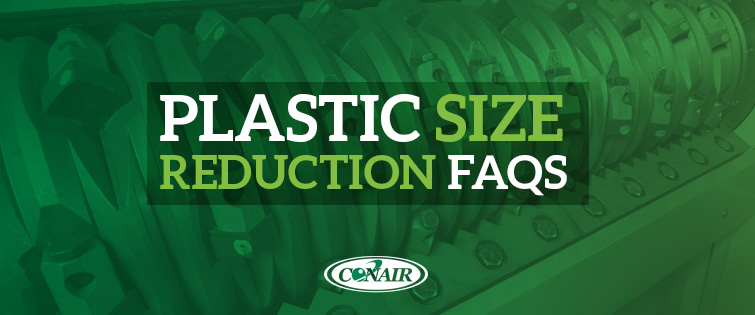There’s an old saying: “The older I get, the less I know for certain.”
经过35年的回答有关切碎和打磨设备的问题,我继续了解什么尺寸减小设备会 - 也不会 - 不会,我经常想起为什么这个陈述是正确的。因此,我倾向于询问有关每个应用程序的越来越多的问题。
At the same time, however, I find that there are a number of comments, questions, problems and circumstances that are quite common – and often a little surprising. In this post, we’ll explore a few of the common plastic size reduction FAQs and how you can avoid any surprises.
吞吐量差异对肉芽的影响
“但是吞吐量等级是。。。”

我接听了很多有关吞吐量的问题。有些涉及潜在客户,这些客户已经根据其大小/吞吐量确定了要购买新应用程序的设备,而当现有颗粒机移至新应用程序时,许多其他客户涉及吞吐量的更改。
就一台新机器而言,有人可能会说:“我在考虑这台机器,因为我需要每小时400磅。”但是,当我们谈论该应用程序时,我经常提出不同的建议,并告诉他们:“如果您需要每小时400磅的特定材料颗粒,则该机器将无法做到。您将需要查看此模型。”
“但为什么?”是问题。“您的网站说每小时400磅。”
“是的,”我回答,“但是,这种材料中有400磅与其中400磅相同。”
这是一个事实some materials are a lot harder to granulate than others。For example, the easiest material in the world to granulate is polystyrene. It processes considerably faster than something like polyethylene or polypropylene. The difference in throughput is night and day, probably 40%.
但是,即使您正在颗粒,吞吐量和性能差异仍然很大。在一个应用程序中工作得很漂亮的颗粒机通常对另一个应用程序不起作用。
一个示例:磨碎宠物预成型与宠物瓶废品
假设您为注射模制的宠物预成型购买研磨机 - 将被吹入更大的瓶子或水罐中的非常密集的小零件。如果您选择一台机器来磨碎宠物的预成型,则不需要大型料斗或切割室,尽管您确实需要能够切开相当厚的零件。因此,您可以使用较小的研磨机,配备了切向室,一个3叶片转子和额外的马力。由于浓汤非常稠密,因此您不需要大量的排放箱。
But if you move that granulator down the line, to where you’re generating PET bottle scrap, you may find that the tangential chamber is too narrow—the bottle either won’t fit or you can’t get the bottles to flow through the chamber, hopper and rotor smoothly enough to keep up throughput. And, because the bottle wall material is much less dense—much lighter—it’s not going to fall as easily through the screen to the discharge bin. It’s also going to overflow that bin much more quickly.
So, if you want to have a granulator that would deliver required throughput for both applications, you’ll want to do a little homework up front. Abetter granulation solution,根据具体细节,可能涉及更大的料斗,超切向室,一个5叶片的转子,更大的放电箱,并且很可能是一个鼓风机系统,不仅可以撤离垃圾箱机器。切换回预成式时,您不需要大的料斗或鼓风机,但是您会欣赏5叶的转子和额外的马力。
材料差异对肉芽的影响
“这是相同的材料。有什么不同?”

在一个具有数百种添加剂和填充剂的世界中,从“设计师聚合物”中磨碎废料总是可能性的。在这种情况下,我学会了对哪种材料(或不会比其他材料都会更容易切碎或颗粒)做出越来越少的假设。
如有疑问,必须测试。
因此,最近,我设置了一项测试,以切碎并磨碎了两个装满炼狱的盖洛德(Ab),每块装满1000磅。所有这些都由相同的基本材料(PP/HDPE与添加剂混合)组成,并且大小(10-40磅),成分和颜色大致相同。出于所有目的和目的,炼狱看起来相同。
Shredder Test #1
我选择了测试shredder对于这项工作,基于处理器的经验和投入,后者产生了许多这些炼狱。处理器需要一个解决方案,该解决方案将提供所需的吞吐量,以满足每个生产转换时发生的“清除激增”,因为人员“拨入”了一种新的配方。
We turned on the shredder and dumped in the first Gaylord. 25 minutes later, great results: Granule sizes were good and uniform—just about perfect. Cuts were clean and sharp. Great throughput. Machine came through in great condition. (A thought: Can we finish before lunch??)
Shredder Test #2
In went the second batch, and out went the rest of the day.
Despite the apparent similarities, these purgings would not process smoothly. The material proved to be stretchy and harder to cut. Friction built up and created heat. Some of the regrind started to soften and melt. A sticky goo accumulated in the rotor screen. Despite cleaning, inspection, and adjustments, the process took hours.
两批切碎之间有什么不同?
A little detective work after the test explained the differences and led to a solution.
在生产线设置早期进行的第一批炼狱包含较高水平的碳酸钙。该填充物的过量作用可软化和润滑切碎过程。
The second batch of purgings—more representative of the production material—contained far less of the filler, but a similar amount of tackifier, accounting for the friction, melting, and mess.
最终的解决方案是带有水冷切割室的更大,更强大的切碎机。通过保持转子冷却,该型号最大程度地减少了摩擦热,使材料更冷,更牢固,并使转子刀能够“握住”并更加干净地切成薄片。这种变化有能力。
如果没有测试,我们将永远不会猜到差异。那将导致一个不好的惊喜!
Impacts on Granulation Quality from Older Equipment
“我需要一个新的研磨机。”

Finally, I still get a lot of people who call and say, “I need a new grinder. Mine just isn’t making it.” So, I ask them, “What problems are you having?”
列表始终包含这样的项目:
- Terrible regrind quality.
- There’s so much dust that I can hardly convey the material. The loader filters are constantly blinded and need constant cleaning.
- 我无法不停滞或堵塞而磨碎这部分。
- This grinder can’t keep up. I can’t get regrind out fast enough.
要检查低品质再生的关键项目
在整个塑料处理中,我一直在收到这个问题,并且我的回答总是相同的:“在考虑新的研磨机之前,请为我做一件事情:打开它,检查刀并削尖。然后,检查刀间隙。”
我无法告诉您我一直在看一台机器,其所有者认为只需要一些东西就可以到达废料堆维护。
有几个潜在的原因上面的problems, but the number one cause is dull or poorly adjusted knives. I know that on some older granulators, it’s hard, and even a little hazardous, to change, sharpen, or adjust the knives. But it can be done. Unless you’re running abrasive or glass-filled materials, you might be able to get away with as few as two or three sharpenings a year. And, knife sharpening/replacement doesn’t involve a lot of downtime—a couple of hours or less, or perhaps a maximum of 4-5 hours on a large machine.
Newer generation granulators通常具有可调节的刀具,可以在颗粒机外固定和调整,从而使锋利刀的安装和维护变得更加容易,更重要的是更安全。对于一些考虑对新设备进行投资的处理器来说,这是一个关键考虑因素。
So, a final surprise, which to me isn’t so surprising: Often, for a particular application, you can fix granulator performance problems by just sharpening the knives and adjusting the gaps. If that doesn’t work, then you’ll know that a service call – or a new granulator – really is needed.
是时候修理或升级尺寸减少设备时该怎么办
Like a lot of other plastics processing equipment, size-reduction equipment doesn’t get much attention unless there’s a problem or an entirely new application challenge.
So, when it’s time for you to repair or upgrade your size-reduction equipment, do two things with the help of your supplier:
- First, review its maintenance/repair history and optimize future maintenance (especially sharpenings!) to maximize equipment performance and life.
- 其次,探索新的降级设备的广泛可配置性,因为精心选择的配置可以减少人工输入,减少马力需求,消除噪音过多,节省能源并增加有价值的灵活性以满足各种应用程序要求。

 724-584-5500
724-584-5500




